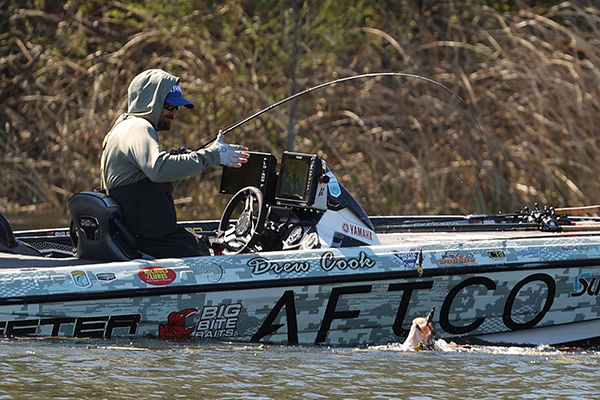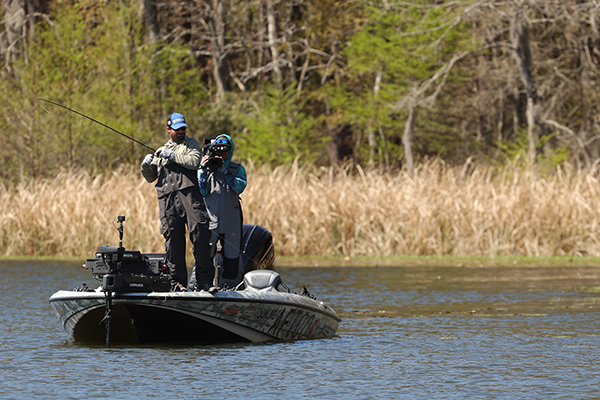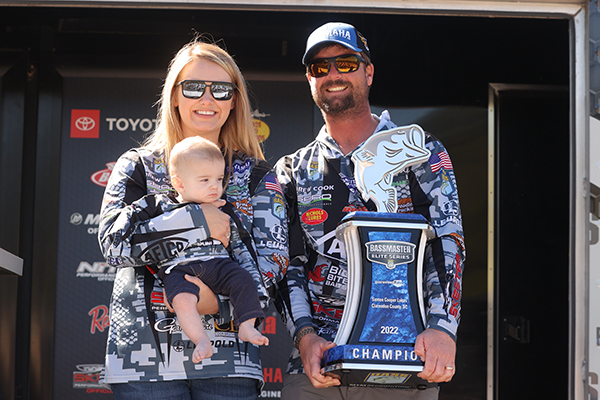Drew Cook had fished South Carolina’s famous Santee Cooper Lakes, Marion and Moultrie, only once previously several years ago, but in a recent Bassmaster® Elite Series tournament there, the Yamaha Pro led the event from start to finish, winning with a total of 105 pounds, 5 ounces. In winning, he followed the very same advice he offers everyone when describing how to locate bass on an unfamiliar lake.

“The very first thing I look for anywhere is the best spawning area I can find,” he emphasizes. “It does not matter what season of year it is, because once you locate the spawning area, you can then find the fish, either in pre-spawn, spawn, or post-spawn mode, because they won’t be far away.”
Once he’s in that spawning area, the second thing Cook wants to do is catch a bass, any bass, because that single fish can help unlock the secrets that will determine his fishing success that day. He often calls it the most important fish of the day.

“You can locate the spawning area by studying fishing reports on the internet if you’ve never been on a lake before,” he explains. “That’s how I identified Potato Creek in the Santee-Cooper tournament, even though I’d never fished it. Several other top-finishing pros also chose Potato Creek and fished there, too. I didn’t know where I was going to fish in that tributary creek, and that’s why the first bass I caught there in practice was so important.
“The bass hit a fast-moving lure hard and immediately tried to move away,” remembers the Yamaha Pro. “That type of aggressive strike nearly always means there are other fish present and there was competition among them to get my lure. This is in contrast to a lighter, more tentative strike, which usually means there are not other bass nearby in competition.
“This is a basic rule that holds true anywhere. That first fish will tell you a lot more if you’re observant, but to me the quality of the strike is critical.” Some additional information that first bass can provide includes the depth of water they’re in, the speed and style of retrieve that triggers a response, and the type of cover or structure the fish are using.
“When I’m practicing for a tournament, I pay attention to all of these pieces of the puzzle,” Cook continues. “When I caught my first fish in Potato Creek, I was fishing in a cove with a fast-moving swimbait around lily pads. It was a quality fish, too, which was important. If your first bass is a very small one or a very large one, they probably are not part of a big school of bass. I want my first bass to be roughly two to maybe four or five pounds, because those are solid school fish.

The Yamaha Pro also believes that when you’re making your first casts in a new area, it’s important to try to cover as much water as possible. That’s why he and other tournament anglers frequently begin with fast-moving lures like spinnerbaits, crankbaits, or swimbaits. Even though catching your first bass of the day on a particular lure like this does tell you what the fish will hit, it may not necessarily be the best or most efficient way to catch them. “My philosophy is to find them first, then figure out how to catch them better,” he laughs. “A plastic worm or a jig might end up being the best lure, but you can never present it to as many bass in the same amount of time as when you’re throwing that swimbait, crankbait, or spinnerbait. Your first goal is to determine if bass are even present where you’re fishing new water.”
Back to Blue Life

“The very first thing I look for anywhere is the best spawning area I can find,” he emphasizes. “It does not matter what season of year it is, because once you locate the spawning area, you can then find the fish, either in pre-spawn, spawn, or post-spawn mode, because they won’t be far away.”
Once he’s in that spawning area, the second thing Cook wants to do is catch a bass, any bass, because that single fish can help unlock the secrets that will determine his fishing success that day. He often calls it the most important fish of the day.

“You can locate the spawning area by studying fishing reports on the internet if you’ve never been on a lake before,” he explains. “That’s how I identified Potato Creek in the Santee-Cooper tournament, even though I’d never fished it. Several other top-finishing pros also chose Potato Creek and fished there, too. I didn’t know where I was going to fish in that tributary creek, and that’s why the first bass I caught there in practice was so important.
“The bass hit a fast-moving lure hard and immediately tried to move away,” remembers the Yamaha Pro. “That type of aggressive strike nearly always means there are other fish present and there was competition among them to get my lure. This is in contrast to a lighter, more tentative strike, which usually means there are not other bass nearby in competition.
“This is a basic rule that holds true anywhere. That first fish will tell you a lot more if you’re observant, but to me the quality of the strike is critical.” Some additional information that first bass can provide includes the depth of water they’re in, the speed and style of retrieve that triggers a response, and the type of cover or structure the fish are using.
“When I’m practicing for a tournament, I pay attention to all of these pieces of the puzzle,” Cook continues. “When I caught my first fish in Potato Creek, I was fishing in a cove with a fast-moving swimbait around lily pads. It was a quality fish, too, which was important. If your first bass is a very small one or a very large one, they probably are not part of a big school of bass. I want my first bass to be roughly two to maybe four or five pounds, because those are solid school fish.

The Yamaha Pro also believes that when you’re making your first casts in a new area, it’s important to try to cover as much water as possible. That’s why he and other tournament anglers frequently begin with fast-moving lures like spinnerbaits, crankbaits, or swimbaits. Even though catching your first bass of the day on a particular lure like this does tell you what the fish will hit, it may not necessarily be the best or most efficient way to catch them. “My philosophy is to find them first, then figure out how to catch them better,” he laughs. “A plastic worm or a jig might end up being the best lure, but you can never present it to as many bass in the same amount of time as when you’re throwing that swimbait, crankbait, or spinnerbait. Your first goal is to determine if bass are even present where you’re fishing new water.”
Back to Blue Life
